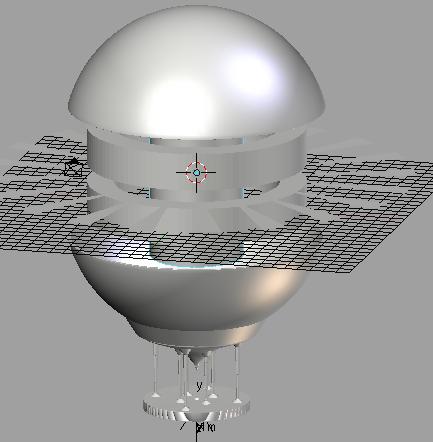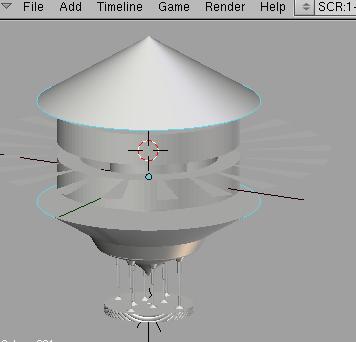Wow, where to start !
dgebel : OK, I’m sold on the hysterisis field. I think I’ll assume a field that’s activated by the proximity of incoming missiles, perhaps with a low-level field that’s on all the time during combat to detect them. I particularly like the idea of using it to slow down filled shells for other systems to destroy them, that’s pretty ingenious.
Or just use non-magnetic plain old artillary shells. I suppose in you need the rail-gun velocity in space - there wouldn’t be enough relative velocity due to the distances involved otherwise. You could easily see the incoming shells and dodge.
The more detailed wargaming can wait until everything’s actually modelled, but it will be necessary to have the ships fairly close together. This will be advantageous to both sides, in a sense, as they could use the closer proximity for more accurate targetting without worrying about the defensive systems so much… but let’s leave that for now (they WILL initally be far apart though, in order to use high-strength weapons, i.e. megaton nukes and so on). More importantly, if the ships are too widely separated there’s little or no scope for narrative. There’s not much point to my mind in going to all the trouble of realism if you go so far that the audience hasn’t got a clue what’s going on.
nyrathwiz :
However, as I mentioned before, the bigger the coilgun gets, the more it acts like an auxiliary propulsion system. The recoil from these monsters will nudge the ship off course, and their mounting brackets had better be sturdy.
As far as estimating how much energy gets into the projectile, your guess is as good as mine. I cannot seem to find any accurate figures. Which probably means they are proprietary or classified. This means you can pull a figure out of the air and get away with it.
Well, from your luminosity equations for the radiatiors I know the available power supply, so I can estimate the availble KE from the charging time, and for any given projectile mass its momemntum, and therefore there coil velocity of the ship. Sticking with a 1 tonne projectile (a nice round number), 5 seconds of charging corresponds to a projectile velocity of 0.9km/s, with a recoil velocity of the ship (let’s say it has a mass of 1 million tonnes) of 0.4 cm/s. As long as the mounts efficiently deliver the recoil to the rest of the ship, it shouldn’t be a problem.
Since the coilguns are going to have huge electrical charges stored in capacitors, if a gun is hit by enemy weapons fire there will probably be a cinematic display of artificial lightning. It will arc all over the place like one of Nikolai Tesla’s toys.
Awesome ! I was going to ask if there was any excuse for something like that. From what little I know of EMP, I’m not sure if it would be a problem from “e-bombs” in space. There’d be the compton scattering of the gamma/x-rays on the hull of the ship, but would this be significant ?
From what little I know of EMP, I’m not sure if it would be a problem from “e-bombs” in space. There’d be the compton scattering of the gamma/x-rays on the hull of the ship, but would this be significant ?
The pusher plate of the Orion drive is already designed to withstand the shock of a nuclear blast. In a battle the ship might want to use it as an impromptu shield, trying to aim it at (the predicted location of) enemy nuclear warhead detonations.
But the pusher plate is designed to handle a specified yield with a specified mass exploding at a specified distance from the plate. You could (or rather, would definately) build in a safety margin, but the enemy won’t be so obliging as to account for your tolerances. What’s to stop their nuke from actually hitting the plate ?
dgebel : Here we go again… this is becoming more of an essay in warship design than a typical post…
One suggestion - you might want change the dedication to in Bob’s memory - I was going to say Sir Arthur’s memory too, but apparently he’s still with us - 89 this year!
And still writing books with Stephen Baxter - good ones too, not like the other times he’s written with a co-author.
I haven’t read Footfall either, but I’ll see if my library has a copy next week. I’ve seen that graphic though (sorry nyrathwiz, too late !), it looks very aesthetic but I don’t think much of it form a design pont of view. The hemispherical pusher would be subject to huge sideways forces as would the curiously-angled shock absorbers. The whole design is very spiky, I would expect evrything to be rather smooth so it could absorb impact shocks better. It has an amoured shield, but it only protects the ship from head-on attacks. What does it do if there’s more than one enemy ship ? I could be wrong, but the guns don’t look like they can rotate in more than one plane to me.
Main thing that I see about the your U.S. concept ship is that size of the shock absorber struts look small to me for the size of the pad. I assume you’ve looked at the original designs fairly closely (plastic coated nukes!  ), have you looked at the revisited design?
), have you looked at the revisited design?
Agree on the shocks. Plastic-coating isn’t as amusing as the… err… fecal-coating proposed for the starship versions though…
I think I’ve read that link before. There’s a lot of reasons for thinking an Orion could be made environmentally-friendly (or friendlier, at any rate). My last version had it boosted above the atmosphere on shuttle-style SRBs. But that won’t be a concern here, as ships this big would be assembled in space, possibly from asteriod-mined metals and whatnot. Apparently you could launch 8 million tonne Orions from the ground… but I wouldn’t want to.
Spherical shape wasn’t for any particular reason, although head-on it would allow all weapons to be fired. Making the nose pointy is probably a good idea. I’ll definately move the rings apart, good point.
Story - I’m thinking of doing some fairly easy supporting scenes to explain why the battle takes place, but that can wait. At this rate I’ll spend more time writing than actually modelling anything…
Hmm, I wonder if I could use some of those real life starmaps for extra super-realism. Blender stars always give ugly results when animated.
way2lazy2ca : I think nyrathwiz has already given a comprehensive answer to that. 
Here are some alternative concepts… now I’m off to finalize it and get on with the modelling. Think I’ll go with the rounder one, just for a different sort of design. It could have a big laser on the top to shoot away anything about to collide with it.
Attachments


![]()
 If you haven’t seen nyrathwiz’s reference link to the Footfall Reference Design
If you haven’t seen nyrathwiz’s reference link to the Footfall Reference Design  ), have you looked at the revisited design? There’s a link with some interesting comments and links at
), have you looked at the revisited design? There’s a link with some interesting comments and links at 